As the days have progressively become warmer in our area, my thoughts have increasingly turned towards warm weather knits. With a fresh, new, and exciting summer design on my needles—the top-down t-shirt counterpart to the Chloe Sweater, the Chloe Tee (I really believe there's nothing more exciting than adding a well-fitting, infinitely re-knittable, effortlessly wearable, and versatile wardrobe basic and staple to your catalogue!)—and plans in my head to revisit my last year's summer basic, the Wayfarer Tee, in different yarns, I have been increasingly preoccupied with exploring different fibers and choosing certain yarns and blends for different occasions.

Warm weather doesn't mean putting away your knitting needles—as knitters, no weather shall keep us away from knitting! Some of us (including my past self and, occasionally, my present self, although this has been changing) continue knitting heavy woollen sweaters throughout the summer, perhaps pausing only during the most intense heatwaves. But as much as we all love cosy woolly yarns and bigger needles, the warmer months offer an opportunity to explore the diverse world of yarns beyond traditional winter wool. So, I thought I'd put together a short guide (just kidding, a very long one because nothing is ever short with me!) to different fibers you can reach for in the warmer months and incorporate into your spring and summer knitting. This guide dives into the best and not-so-best fibers for warm-weather knitting, showcasing how each contributes to creating perfect seasonal garments. Furthermore, we'll unravel the reasons wool remains an unexpectedly excellent choice for spring and summer projects.
Why have I incorporated the spring season here? Well, for those of us, like me, living in the south of Germany, mid to late spring and often early spring can already signal a shift to lighter garments.
So let's dive in, starting with the obvious choice! (Yes, you guessed it, it's our good old friend cotton!)
Cotton: The Cool Classic
When I say 'T-shirt,' you likely think 'Cotton.' And while with advances in the clothing industry and a growing appreciation for different natural materials and their application in garments—with the clothing industry, especially on the functional and outdoor clothing side, having an increasingly technical approach to garment creation for season and function, including the newfound appreciation of wool and merino wool across all seasons especially in functional clothing (I don't know how I'd survive our humid, hot summers without my trusty store-bought lightweight merino wool tops and tanks—or how I'd ever do any physical activity outside like hiking without them)—nevertheless, when you say 'Tee', I think: 'Cotton'.
And there's nothing inherently wrong with cotton; a nice selection of classic high-quality cotton or organic cotton tees is a must in anyone's wardrobe. Cotton is the durable and reliable good old classic we know for its soft, comfortable, and breathable fabric. It is versatile and has pretty decent moisture control as it can absorb some of its weight in water. Of course, it also has its drawbacks: it can be heavy, it is prone to wrinkles, and when knitted into a garment, it can stretch and grow in unpredictable ways. Cotton lacks elasticity, so it doesn't bounce back like wool after stretching. So, you need to account for the fact that it will stretch after washing and blocking, and it will continue to stretch with wear, so it is a good idea to rather size down when choosing a size for a summer garment. This tendency to grow and stay also complicates things when it comes to knitting ribbing and necklines; in some cases, it is a good idea to add elastic to your neck ribbing to help it retain its shape. Cotton also has really nice stitch definition, although it can be slippery to knit with. And it takes on dye really easily, which means that there will be many vibrant colours to choose from. It is also relatively inexpensive, making it an affordable choice for summer knitting for the budget-conscious. It is also a good vegan choice if you want to avoid or are sensitive to animal fibers.
The biggest drawback of cotton as a fiber: nothing stays damp as long as cotton, which does not have any inherent temperature-regulating properties on its own and it's insulating properties are limited, becoming non-existent the moment it gets wet. That's why you should never hike in jeans and a cotton T-shirt—and why cotton is an especially terrible material for wet, rainy, dreadfully cold months, -the last thing you want is to be caught in a downpour with only cotton on. Wearing pure cotton in hot and humid conditions might be uncomfortable due to its tendency to absorb moisture and retain it, leading to a damp and sticky feeling. However, wearing cotton in cold, wet weather or during high-exertion activities in colder months can be even more problematic. When cotton gets wet, it loses its insulating properties, which can lead to rapid body heat loss, making the wearer feel cold and increasing the risk of hypothermia in cold conditions.
Cotton is generally categorized into various types, with Supima and Pima cotton standing out for their high quality. Both are grown under ideal conditions, known for producing long-staple fibers, which are about twice the length of regular cotton fibers. This results in several benefits: unmatched softness, superior strength, exceptional drape, and less pilling. Supima cotton, a premium variant of Pima, is especially noted for these attributes.
Mercerized cotton, on the other hand, undergoes a chemical treatment that strengthens the fibers, enhances dye absorption, and removes surface fuzz, leading to a more lustrous finish, more vivid colors, enhanced durability, and a smoother texture.
When knitting, consider the gauge differences between these cotton types; Supima/Pima typically requires finer needles than regular cotton. Also, the smoother texture of mercerized cotton may influence your stitch definition, providing crispness that differs from the slightly softer stitches you'll get with Supima/Pima.
Ultimately, the choice between Supima/Pima and mercerized cotton will depend on your project's needs: Supima/Pima offers softness and durability ideal for luxurious wearables, while mercerized cotton is best for items requiring a sleek finish and vibrant colours.
Organic cotton is grown using methods and materials that have a low impact on the environment. The production systems used for organic cotton avoid the use of toxic pesticides and synthetic fertilizers, promoting a healthier ecosystem and reducing pollution. This type of cotton is typically grown from non-genetically modified plants and is cultivated without chemical additives, ensuring that the soil, air, and water remain uncontaminated.
Organic cotton benefits include being safer for cotton producers and their communities, preserving biodiversity, and reducing the ecological footprint associated with cotton cultivation. In textiles, organic cotton offers the same comfort and durability as conventional cotton but with a focus on environmental and ethical responsibility. For consumers concerned with sustainability and ethical manufacturing, organic cotton presents a more eco-friendly and socially responsible choice.
Some good choices of cotton yarn could be Sandnes Mandarin Naturell and Mandarin Petit, Japansk Bomuld, Cascade Yarns Ultra Pima, CaMaRose Økologiske Pimabomuld and Katia Fair Cotton. That being said, these are general recommendations, and I've never knit with pure cotton yarn because I have from the start automatically reached for cotton blends to get all the great qualities of cotton with added benefits from other fibers.
So let's talk about blends.
The obvious choice: Cotton-Merino
This combination is definitely my favourite for summer knitting, and some of my most favourite yarns fall into this category - Saona by Wooldreamers, which for good reason has been everyone's darling since its release in 2023, as well as everyone's favourite go-to summer staple - Knitting for Olive Cotton Merino.
What I love about combining cotton and wool is that you get the best of both worlds. You get the strength and durability of cotton with added softness and drape. You enjoy the breathability of cotton, with the added temperature-regulating properties of wool. You benefit from the moisture-wicking properties of cotton supplemented by the superior moisture-wicking properties of wool. But unlike cotton wool still feels nice to wear even when damp and retains it's temperature regulating properties, while cotton just feels damp and does not dry fast. While cotton is comfortable and soft to wear, wool provides extra insulation, and merino wool offers a softer, cosier feeling against the skin. While pure cotton can be comfortable to wear directly in summer, cotton-wool blends are more versatile, making the garment more of an all-rounder for all seasons. Adding plant fibers such as cotton can help reduce the pilling of wool in a cotton-wool blend garment. The addition of wool to the cotton enhances not only elasticity but also shape retention, as pure cotton has trouble keeping shape and stretches out over time.
I've already listed my two all-time favourites, but let's talk for a moment about how they are different.
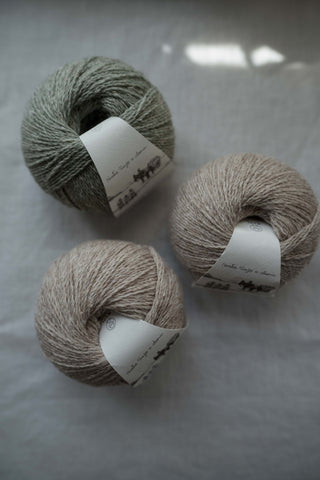 Saona Yarn is a Spanish yarn from Wooldreamers, and it is a blend of 50% cotton and 50% local wool, which is a mix of Manchega and Merino wool. This special mix adds a very interesting character and texture that I've not seen in other similar content type of yarns but that will feel very familiar if you are a Wooldreamers aficionado and have had experience working with their spun or unspun yarns before. They all seem to, to one degree or another, feature a very characteristic squishy soft bounciness - sorry, but I lack a better way to describe it. I think it makes it really enjoyable to knit with; it is less slippery and more sticky than, say, Cotton Merino from KFO, so it is easier and quicker to work with even on metal needles. It is a perfect blend between soft and comforting against-skin cotton-wool blend but it retains just the right amount of a rustic character that makes it truly unique. While it does have some drape, especially after blocking, it is not a lot - and this is an advantage if you want to work on summer lace tops like my design from the previous year, the Summerwood Tee, or if you want to incorporate textured patterns such as cables in your summer garments, while it is also great for boxy tees in pure stockinette stitch.
Saona Yarn is a Spanish yarn from Wooldreamers, and it is a blend of 50% cotton and 50% local wool, which is a mix of Manchega and Merino wool. This special mix adds a very interesting character and texture that I've not seen in other similar content type of yarns but that will feel very familiar if you are a Wooldreamers aficionado and have had experience working with their spun or unspun yarns before. They all seem to, to one degree or another, feature a very characteristic squishy soft bounciness - sorry, but I lack a better way to describe it. I think it makes it really enjoyable to knit with; it is less slippery and more sticky than, say, Cotton Merino from KFO, so it is easier and quicker to work with even on metal needles. It is a perfect blend between soft and comforting against-skin cotton-wool blend but it retains just the right amount of a rustic character that makes it truly unique. While it does have some drape, especially after blocking, it is not a lot - and this is an advantage if you want to work on summer lace tops like my design from the previous year, the Summerwood Tee, or if you want to incorporate textured patterns such as cables in your summer garments, while it is also great for boxy tees in pure stockinette stitch.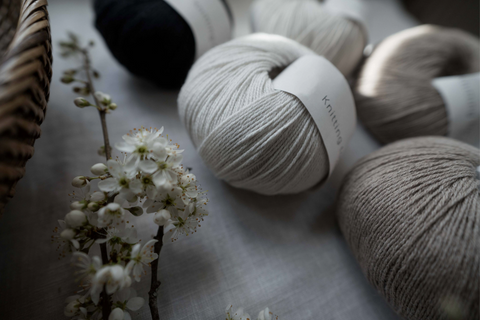
KFO Cotton Merino is absolutely stunning and has a wide range of beautiful colour choices that make it frankly so hard to choose and so wonderful. But its characteristics are its own - for one, it has a much higher cotton content, 70% cotton and 30% RWS certified Merino wool. This yarn is trickier and slipperier to work with - you may want to choose wooden needles - due to its higher cotton content, but it also is so worth it, as it creates very wearable summer garments with the most beautiful drape and excellent stitch definition. If you want your summer top to look and feel store-bought in the best way possible, it is an excellent choice.
Other alternatives for cotton-merino blends include BC Garn Bio Balance, Økologisk Sommeruld from CaMaRose and Sandnes Duo.
And if you're in Germany/EU - @gutegarne_official online shop has some wonderful kits with my patterns including the summer designs in BC Garn Bio Balance, Allino, and more here.
Cotton Silk - The Sleek One
Adding silk to cotton can create a more luxurious feeling for the garment - it's the same soft comfort but with an added touch of elegance. Silk also introduces a beautiful and elegant sheen to cotton, making the fabric appear more sophisticated. If wool isn't for you, you can still benefit from the added temperature regulating properties of silk. Silk possesses a nice cool feel, but it is not as moisture-absorbent as cotton or wool, which is where silk actually benefits from the addition of cotton without losing its cool, luxurious feel. Regarding durability, silk is a strong fiber, particularly in terms of tensile strength, meaning it can withstand a lot of tension before breaking. However, silk fibers can be more prone to wear from abrasion and damage from sunlight and perspiration compared to cotton. The blend of cotton and silk aims to balance these aspects, creating a fabric that combines the strength of silk with the everyday durability and usability of cotton. But because of silk's moderate moisture absorbent properties, and adding silk to a cotton blend would be recommended if the garment you are creating is intended for use in less exertion-heavy activities and more moderate climates.
However, pure cotton-silk blends are not as common, and it is more common to see pure 100% silk or cotton and silk blended with wool/alpaca, and more commonly the wool/alpaca content is the highest. That's not to say they don't exist, but they are harder to find. One such example is Lana Grossa - Landlust Sommerseide, which contains 50% cotton and 50% silk, and Rico Design Luxury Organic Cotton Silk.
Cotton-Linen - The Quintessential Summer Fabric
If anything screams 'summer'! Both of these materials are highly breathable, perfect for warm weather. The fabric allows air to circulate freely, which helps in keeping the you cool and dry. Cotton is excellent at absorbing moisture, and linen dries quickly. Together, they complement each other by creating a fabric that can effectively absorb moisture from the body and release it to the environment, ensuring the wearer stays dry and comfortable. Linen becomes softer with each washing, and when combined with the naturally soft fibers of cotton, the result is a fabric that feels gentle against the skin, improving with age without losing its durability or shape. Both cotton and linen offer a natural, earthy feel and look, which can add a classic and understated rustic elegance to clothing, different from the silky sheen of silk, yet still adding a feeling of quality and luxury. While both linen and cotton are prone to wrinkling, linen softens and becomes less prone to wrinkling with time, and cotton mitigates the initial stiffness that comes from 100% linen, while maintaining a natural texture. Linen, known for its superior strength and durability - stronger than cotton - will definitely add value in this department.
Cotton and linen are both natural fibers that are biodegradable. Linen, in particular, made from flax plants, requires less water and pesticides than cotton. Blending linen with cotton can therefore reduce the environmental footprint of the fabric while maintaining its natural and sustainable qualities.
While you can of course create upper body garments such as T-shirts or sweatshirts with linen, cotton-linen blends are versatile and can be used for a wide range of garments and textiles, from linen dresses and shorts to accessories such as tote bags and home textiles. While cotton is breathable, so is linen; linen is renowned for feeling pleasant and cool against the skin and is quick to dry. Linen can also absorb a significant amount of moisture without feeling damp, adding to the moisture-absorbent properties of cotton. Linen also adds an improved drape and a lovely crisp feel to the softer cotton, resulting in a fabric that hangs beautifully while retaining the natural feel. Similarly, while many still think of 'cozy autumn and winter garments' when wool is mentioned, some perceive linen as a summer material as it is more commonly seen in clothing and bedding during the warmer months. However, while linen may not be the obvious choice for colder months, it is versatile and provides thermal insulation, keeping the wearer cool in summer and warm in winter, making it versatile across all seasons. If you live in a hot and humid environment, cotton can actually be detrimental to linen as it tends to retain moisture, resulting in a damp feeling. You'd benefit more from pure linen because cotton tends to hold onto moisture, resulting in a damp sensation.
But this is also not a very common blend, which limits choices. You can also find cotton-linen blends mixed with other natural and synthetic fibers.
A great choice with equal cotton and linen content is BC Garn - Allino.
Isager Bomulin is another great summer yarn if you don't mind the blend being slightly heavier on the cotton side. In the same way, you will find some nice choices if you are open to different blends and content percentages of linen, from Isager Trio 1 and Trio 2; the first having a percentage of bamboo (although there seems to be conflicting information whether Trio 1 has lyocell or bamboo, did they update it by any chance?) and the latter lyocell (a form of rayon made from wood pulp and the more environmentally friendly version of rayon that you might be more familiar with from its one of the most popular brand names, Tencel. Lyocell also adds to moisture management and breathability and has a lovely soft, drapey feeling to it). While I haven't worked with any of the aforementioned, I have trust in Isager's quality and I have never been disappointed with any of the yarns I've worked with from them. Line and Tynn Line from the well-known Norwegian brand Sandnes is another popular cotton-linen mix although the linen percentage is very small and it has added viscose (the less environmentally friendly form of rayon derived from wood pulp, that while has a dry and silky feel beneficial in a summer garment, ultimately is less moisture absorbent and durable than lyocell) so if I had to choose, I'd choose Trio 2 over Sandnes Tynn Line, simply because of the higher linen content and lyocell being a minor player and the better option of the two while in Line viscose is a higher percentage than linen.
So how do these fibers fare on their own?
Silk
Pure 100% silk will feel more lustrous, smoother, and softer, creating a truly more luxurious feel against the skin. While cotton is soft, it does have a slightly more textured character to it than silk. Pure silk has a glossy sheen appearance making it suitable for more luxurious garments. Silk's beautiful sheen and drape gets muted in blends. Silk also has great temperature-regulating properties, regulating your body temperature to keep you cool or warm, making it a great choice for all year round and more versatile than pure cotton. Silk is durable although not as much as cotton; and it has a nice cool feel on skin which is lovely for warmer months. But it is also not a fiber meant for lots of activity or very hot and humid environments. While absorbent, it does not absorb as much moisture as other fibers and it does not wick away moisture fast enough and it dries slower than other fibers such as linen and merino wool. Silk is a protein based fiber so while it can tolerate some sun exposure it will weaken with prolonged exposure to UV light. Pure silk is also more expensive than cotton or cotton-silk blends, so that is something to consider if you're budget-conscious. As for yarn recommendations, you can't go wrong with Knitting for Olive - Pure Silk.

Linen
Linen and linen yarns have a uniquely rustic texture that initially feels much rougher than cotton or any other plant or animal fiber. However, linen softens considerably with time and only improves with wear, becoming beautifully soft and comfortable. You may have heard that linen clothing only gets better with time, making linen a great long-term choice due to its exceptional strength, durability, and longevity. Linen possesses both highly breathable and temperature-regulating properties, keeping you cool in the summer as well as warm in the winter—though it's not necessarily the sensible choice for winter, as wool performs better in colder months. Linen can absorb up to 20% of its weight in moisture, which is why it's so suited for summer tops as well as for towels and bedding. Unlike wool and cotton, it doesn’t retain moisture; instead, it releases it back into the air, making this fiber excellent for hot and humid climates. The downside is its proneness to wrinkles when used on its own. It's also a great choice for knitting tote bags due to its durability.
My favorite linen yarn is Hør Organic from Isager, but BC Garn Lino or CAMAROSE – LØVETAND can provide lovely alternatives.
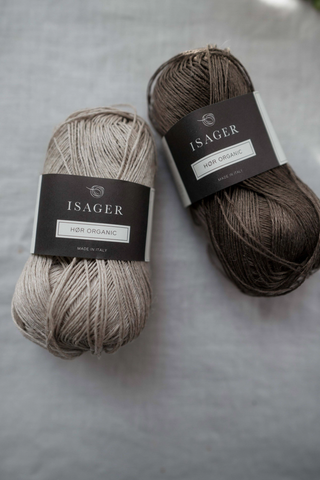
In general, I would advise against opting for cheap linen as the difference in knitting experience and the final result is noticeable unless you are knitting a 'throwaway' item, such as a simple bag for groceries/carrying that will not be against your skin or in a garment you want to cherish for years. In my experience, such items are of much rougher texture and result in less aesthetically appealing garments.
Linen and Alpaca - A Match Made in Heaven?
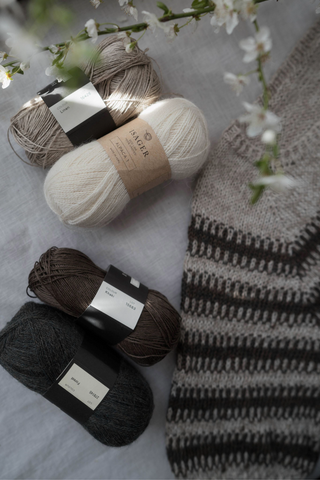
While cotton-linen is quite the summer marvel, there's just something so incredibly special and beautiful that is created when you combine 100% linen with lace-weight alpaca yarn. The initially rough and stiff texture of linen gets immediately softened and becomes much easier and truly enjoyable to work with. The resulting fabric is rustic in feel yet possesses the soft, luxurious, fuzzy gentle feel from alpaca. Both fibers are temperature-regulating, complementing each other, and are moisture-absorbent. The created fabric has a truly unique tactile feel and a unique texture that is beautiful on its own but can be further enhanced with added minimalist textured stitch patterns, like in my Bjørk Top. The garment is also hypoallergenic and natural—alpaca is a good choice if you're allergic to wool as it does not contain lanolin, which is often the allergen in wool. Both alpaca and linen are considered eco-friendly fibers. Alpacas have a light environmental footprint, and linen is made from flax, a plant that requires less water and pesticides than cotton, making the blend appealing for those looking to make environmentally conscious textile choices.
A linen-alpaca blend is ideal for those seeking a yarn that combines the rustic, natural feel of linen with the soft, luxurious warmth of alpaca, resulting in versatile garments suitable for a variety of seasons and occasions.
And of course, the combination I am talking about is none other than Hør Organic from Isager combined with Alpaca 1 from Isager.
The Unlikely Summer Hero: Wool
So what about wool? As we've already discussed earlier, contrary to popular belief, wool can be a star in summer knitting, thanks to its unique properties. Of course, I am referring to lightweight wool—from fingering to Sport or Light DK—not your favourite Heavy Worsted weight sweater. Although, there have been many summer evenings where, after cooling down after sundown and a day of being outside, maybe swimming, there's nothing more comfortable than warming up in a big, nice woollen sweater, and I use my cosy knits all year long.

Of course, not all wool is the same, and a lot will come down to the breed of sheep. When talking about summer knitting, we most often refer to merino wool, but not exclusively. Working with lightweight wool like Merino is a joy due to its softness and elasticity, offering a stress-free knitting experience and making it suitable for a range of projects. Wool's inherent ability to regulate temperature means it keeps you cool when it's hot and warm when it's cool, making it an excellent choice for summer evenings or overly air-conditioned spaces. It also has amazing moisture-wicking properties, up to 30% of its weight. Merino wool generally has superior moisture-wicking properties compared to regular wool and is soft, breathable, and lovely to wear against the skin. All in all, it is also a nice choice for warmer days; however, it has a heavier feel, and I would not recommend handknit merino garments in very hot, humid summer climates.
While I personally live in merino wool almost all summer long when it comes to high-exertion activities in hot and humid climates, it is store-bought technical clothing and behaves differently. The store-bought tees are usually made of very fine, lightweight merino wool optimized for performance. A handknit T-shirt is heavier and warmer and will be more suited for cooler summer evenings and more casual use.
So, as you can see, the best choice will be determined by your individual preferences, your knitting project and goals for the garment, and your climate—there is no one-size-fits-all solution, but you already knew that. However, I hope that you have learned a little bit about the individual fibers and how combining them can often complement each other and bring out the best in each, altering your project accordingly.
My go to light merino yarn is Knitting for Olive - Merino, but you could also choose Sandnes Tynn Merinoull, Sandnes Sunday by Petite Knit, Pascuali Merino Baby, Rosy Green Wool - Cheeky Merino Joy and many more.
So, to finish up, here are some summer designs and how the different fibers would suit them.
Wayfarer Tee - A classic box raglan style tee designed in KFO cotton merino, meant to be a wardrobe staple and a basic you can easily knit over and over again. This design allows for great play and customizability, and its plain stockinette stitch allows you to experiment with various yarn combinations without worrying too much. Great alternatives would be any cotton merino yarn of similar weight that meets the gauge, such as Saona from Wooldreamers or BC Garn Bio Balance. Alternatively, turn it into a luxury piece—something I am planning on as soon as I get to it—and knit it in KFO Pure silk. Create a more rustic version by adding linen to the mix—the options are endless.

Summerwood Tee - Designed in Saona from Wooldreamers. As I mentioned earlier, Saona does not have a lot of drape and has a more sticky and bouncy feel to it, which benefits a lace pattern like the one in the Summerwood Tee. The lace pattern contributes to the airiness and can be chosen to knit on the front and back or only the front. I would not recommend using just any cotton merino blend but look for cotton merino yarns of similar characteristics—with a more rustic, bouncy feel without a lot of drape—something that can retain shape more. I personally would not use linen, cotton, or silk for this because of the heavier drape—the lace holes might stretch out (but you're welcome to try!). However, I could imagine a pure merino version looking lovely for cooler days.
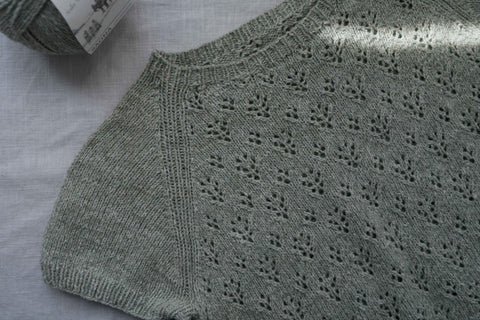
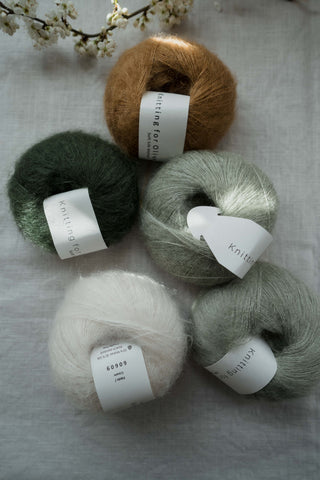
 The fabric created by working with a single strand of unspun Nutiden is one of the lightest things imaginable, to the point that it feels almost ethereal. And while unspun yarn, single-stranded, is fragile, it is not when knit up, so you end up with a lightweight cloud reminiscent of spider webs that is surprisingly durable and warm for its weight. Yet, it is still wool—not silk mohair—so it will behave like wool, with good and not-so-optimal attributes for summer days. That said, it's an interesting alternative to explore for milder days and cooler evenings. But to make it more summer-friendly, you could easily switch out the warmer fibers for something more summer-friendly such as Sandnes Line, which would suit the gauge. Since it is a stockinette project with a simple colour blocks, it also offers room for different interpretations and can be made summer-friendly by a simple shift of yarn.
The fabric created by working with a single strand of unspun Nutiden is one of the lightest things imaginable, to the point that it feels almost ethereal. And while unspun yarn, single-stranded, is fragile, it is not when knit up, so you end up with a lightweight cloud reminiscent of spider webs that is surprisingly durable and warm for its weight. Yet, it is still wool—not silk mohair—so it will behave like wool, with good and not-so-optimal attributes for summer days. That said, it's an interesting alternative to explore for milder days and cooler evenings. But to make it more summer-friendly, you could easily switch out the warmer fibers for something more summer-friendly such as Sandnes Line, which would suit the gauge. Since it is a stockinette project with a simple colour blocks, it also offers room for different interpretations and can be made summer-friendly by a simple shift of yarn.
As you can see, you can achieve so much by experimenting with different fibers and combinations, adapting them to your needs and project. Understanding which yarn you should choose becomes easier if you understand the fibers involved and the content present. It becomes incredibly fun to reknit the same tee in many different variations. I think, tiny stitches, hurting wrists, and long project completion dates aside, there is inherently more room for discovery in warm-weather knitting. In cold weather knitting we can explore different yarns and yarn weights, woollen vs. worsted, unspun vs. spun, different characteristics of sheep breeds, all of which will alter the result, of course—a different combination of spun yarns, adding silk mohair, and lace-weight yarns such as alpaca lace, and so on but nowhere is the difference as stark as in summer knits. If you don't believe me, go knit a Wayfarer tee in cotton merino, and then try it in pure linen and see! Of course, you could do this with a sweater, but there is a line where certain adaptations just don't make sense.
Choosing between different yarns and fibers isn't only about the material itself—it's about how each one aligns with your knitting project, meets the specific requirements of your project, and suits the climate in which you live. It's about finding the perfect match for your needs, whether it's the breathability of linen, the soft insulating properties of wool, or the unique blend of cotton and silk.
I hope you enjoyed this not-so-short guide to summer yarns, and perhaps found some yarn or pattern inspiration for your warm-weather knitting projects. And please feel free to leave a comment if you have a favourite must-have summer yarn or a preferred fiber type! Happy knitting!

